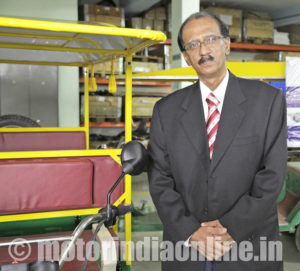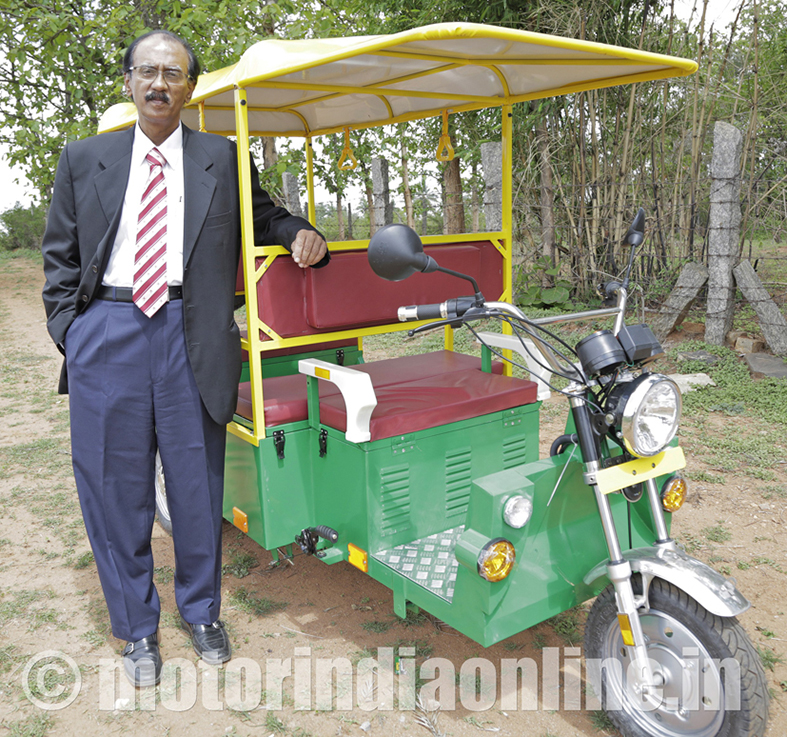Tucked away in green surroundings of Nelamangala in Bengaluru is Transvahan Technologies that was established in 2007. The brain-child of Mr. S.R. Venkatesan, Managing Director, Transvahan is big on uninterrupted research and development of sustainable mobility. With focus on research and development of solutions in sustainable mobility, what with his own experience of more than 30 years in the commercial vehicle sector, Mr. Venkatesan tries to offer solutions that take into account the basic units involved – Road, Load and Mode of Transport, in short, ROLOMO.

Mr. Venkatesan feels that a wholesome sustainable solution in mobility must reflect synergy between the way roads are constructed, the endurance and longevity of the vehicles that ply on them and the way economy is moved in terms of people and goods, combined with factors like emission control, safety and comfort.
Mr. Venkatesan explains the works at Transvahan: “Sustainable Mobility comprises studying the material being used, the fuel, continuous dissemination of knowhow and knowledge, so that we can see if the material that is used will have a long life, if the fuel offers a finite or infinite life and now, you see alternate fuels have come into existence. Transvahan works towards this and, with the cooperation of a Swedish company, we manufacture hydraulic winches for load handling and self-recovery operations in truck-based systems.”
Transvahan also produces electric winches, power drives, accessories, parts and hubs that cater to both consumers and industrial end-markets.
He adds: “We have also started winter testing for which we work closely with OEMs and take vehicles to Sweden for it. We check the performance of the vehicles in low ambient temperatures and conditions like snow, to study to what extent the manufacturing and design can prevent coagulation of oil.”
Future of Indian automobility
India is a signatory to the UNECE World Forum for Harmonization of Vehicle Regulations (WP.29). As a compliant partner, India is committed to follow the three UN Agreements and conforming to the regulatory instruments, namely, performance-oriented test requirements to ensure safety, environmental concerns and administrative procedures; globally harmonized performance-related requirements and test procedures to provide for a regulatory framework for the global automotive industry, and consumers; and lastly, periodical technical inspections of vehicles in use.
Mr. Venkatesan offers a perspective: “India follows the European regulations so we must also follow the regulations, including those of emission and safety norms. Combined with that are the challenges that we face with regard to fuel which is diesel predominantly that is used on trucks and buses. This forces us to sit up and find out sustainable mobility solutions. The future is electric mobility, so technology, design, training and basic construction itself – all owe to heavy investments in R&D.”
Transvahan is fully prepared for the scenario. He talks about his prized products – E-Rickshaw and E-Cart: “Electric vehicles can carry more goods which will address the air pollution issue. Then infrastructure constraints like charging stations, mileage that they offer and other such issues can be easily addressed. Transvahan has recently received approval from ARAI for our E-Rickshaws, and once the registration process is completed, we shall be ready to launch them in the market. Regarding E-Cart, we are developing it and hope to support the logistics sector in a big way.”
Currently, Mr. Venkatesan is planning for a batch of 30 E-Rickshaws. And he feels that in India, it is only a matter of time before the market will be flooded by demand for vehicles offering electric mobility.
Driver skilling
One major aspect of sustainable automobility is the driver! And Transvahan has been consistently working towards improving the quality of their lives.
He agrees: “The driver fraternity in India has evolved from the cleaner who apprentices with the drivers, but the moment we have safety norms to fulfill, we need drivers to learn how to handle the vehicles that come with advanced technology today. Can he open the bonnet of the truck on the roadside and repair it? No, because he is not trained. Transvahan takes training its drivers in its logistics division seriously.”
Transvahan started logistics operations in 2012 with around seven small commercial vehicles for distribution within the city. Soon, it plans to launch long haul operations and special application vehicles too.
He shares: “We built brand new container bodies to make sure that the goods will be safe and secure. We always pick our drivers after a rigorous screening process and train them where they come to know about the vehicle and they carry its history card that is always available on the vehicle. This card will show when the maintenance is due and what pre-travel checks he must perform, and how he should keep the vehicle clean. We also teach the driver little soft skills and why he should dress well.”
According to Mr. Venkatesan, operating a much larger fleet has been in demand by his customers, but his constraint is what the industry as a whole is experiencing driver shortage. On its part, Transvahan has been encouraging drivers by awarding them top fuel consumption slot and safe driving besides zero challan from the traffic police.
He observes: “Transvahan has been working towards skill development to bridge the gap and to help people find employment. We have helped more than 1,400 candidates who had mixed diplomas, or were school dropouts, or have studied in polytechnics or even those who were engineering graduates. Some have found jobs in the automotive sector, or are into product development and design. Some have found jobs with Indian OEMs too. We offer automotive workshops in colleges and some OEMs also, besides training RTOs on technology. We officially partner with KSDC, NSDC and ASD or automotive skill development, too.”
GST – paving smoother path
The Indian industry is welcoming the move to roll out GST with open arms even as SMEs and businessmen are wracking their brains in resolving the nitty-gritty nuances of it.
Mr. Venkatesan sees GST paving a smoother path when it comes into existence: “The logistics sector in India will benefit with this paradigm shift. But GST is only one step. The next step is about how the whole industry, that was organized with focus on automotive industry and components, will pan out with geography-specific warehousing activity taking priority. It will be a seamless flow and will save cost as well, and it will be upto the manufacturers if they wish to pass on the benefit to the end customer.”
Mr. Venkatesan, though, wishes for a change in the psyche of the average Indian driver. He feels: “We have better roads now, and also better national highway infrastructure. We have golden quadrilateral, the East-West corridor, expressways where it is possible to touch speeds of 100-120 kmph. But it is also true that there is an increase in the number of accidents because till now the average speed of commercial vehicles was 15-20 kmph. Neither is an average Indian citizen’s body nor mind is attuned to this.”
While his lamentation holds true, India as a country must think on a broad-based perspective. Sustainable mobility is the need of the hour, but so is training the drivers to bring them upto the mark, and Transvahan is going all out to make it a reality.
